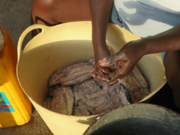Cuisine of Equatorial Guinea

The cuisine of Equatorial Guinea is a mix of foods from different native groups in this African country. These groups include the Annobonese, Bubi, Fang, and Kombe people. The food is also influenced by Spain, which ruled the country until 1968. Other influences come from nearby African countries like Nigeria and Cameroon, and even from Islamic states like Morocco. Overall, it has a taste of Creole cuisine.
Equatoguinean food uses various meats, including wild game and imported types. It is known for its strong flavors and often spicy taste. Fish and chicken are very common dishes. Even though recipes change between communities, most groups use similar ingredients. Soups and stews are very popular. Root vegetables like yuca and yam are a main part of the diet, usually boiled or fried.
The warm, wet climate helps many vegetables grow, such as eggplant. Many fruits also grow well, like atanga. The jungle provides special herbs and wild animals for food. Since many people in Equatorial Guinea fish, their most famous dish is pepesup. This is a spicy fish soup. Meals usually have a stewed sauce at their center. Dishes cooked wrapped in banana leaves are also common. Main meals often come with rice or boiled or fried yuca, malanga (a type of taro), or plantain. Some dishes from other countries are also popular, like the Spanish omelette and Cameroonian ndolé.
Chilies and other spices are widely used. Important ingredients in Equatoguinean cooking come from local plants and animals. These include plantains, sweet potato, breadfruit, cassava, yam, and cocoyam (called malanga there). Groundnuts (peanuts) and snails are also used.
For desserts, a special treat is akwadu. This dish features baked bananas with coconut. For drinks, people enjoy topé, which is a traditional palm drink, and malamba, another local drink. Equatorial Guinea used to produce a lot of coffee and cocoa. This was especially true during the time it was a colony. However, production has dropped a lot since then. What people call "chocolate" in the country, also known as modica, is actually a seed from the African mango tree. It is sold as a powder or in a block.
Farming in Equatorial Guinea is mostly done on small farms. It is not a big industry. Sadly, many people in the country still only eat one meal a day. But for special events like weddings, people celebrate with big feasts.
Popular Dishes
Here are some popular dishes you might find in Equatorial Guinea:
- Peppersoup: This is a West African soup. It usually has pepper, different meats, and nutmeg. It is known for being spicy and flavorful.
- Sopa de pescado con cacahuete: This is a peanut soup with fish. It also includes onions and tomatoes.
- Bambucha: This dish is a stew or sauce made from tender cassava leaves. The leaves are crushed and boiled with spices. It also has juice from palm kernels, which are locally called dates. Bambucha is often eaten with boiled or fried plantain or yuca.
- Equatoguinean dishes
See also
 In Spanish: Gastronomía de Guinea Ecuatorial para niños
In Spanish: Gastronomía de Guinea Ecuatorial para niños





